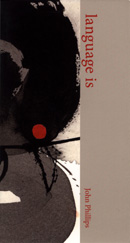It’s hard not to like John Phillips’ Language Is, from Sardines Press. Phillips, a British poet who has spent the past decade in Slovenia & now returned home, writes with a precision, balance & grace that calls to mind the very best of Louis Zukofsky’s short poems, or Creeley’s early period, or Lorine Niedecker’s work. At his best, Phillips is absolutely dazzling:
Seeing how
each thing
singly is –
that tree
a tree
its leaves,
leafs
Or, also untitled:
What we read
we write
ourselves
into
the text of.
Yet this work comes to us now not only decades removed from the age of Objectivism or Projectivism’s first decade, but some 40 years after the heyday of Ted Enslin & or James L. Weil as well. Indeed, in the late ‘60s & early ‘70s, there were dozens of younger poets similarly focused in their concerns. Those who went on to have significant careers – David Bromige would be an example – saw these same concerns evolve. Still, every decade sees a new group of young poets emerge insisting on this same level of precision.
My own sense is that I inherently trust this impulse, especially when I see it coming forth slightly askew, as if to suggest that the poet has a somewhat different angle on the whole thing. Graham Foust & Joseph Massey would be good recent examples of such slanting. They may well be of the tradition, but they extend it into places where it has not previously gone.
The arts in general, and poetry in particular, are quite unlike most modes of commerce in that the new doesn’t necessarily push out the old so much as it nudges it aside just slightly so as to make room for more. It’s not like, say, the PC sending typewriter companies like Smith-Corona to the corporate graveyard. In poetry, new forms mean more forms. The three major innovations of the 19th century, for example, free verse, the prose poem and dramatic monologue, continue forward to this day. Yet so does the sonnet. And, according to Google, there are just under 18 million websites that mention haiku.
Invariably a point comes when the evolution of these forms slows and people become more interested in reduplication of the form than in pushing it further. That’s the story with haiku & a good part of the story with dramatic monolog (which hasn’t had a major push forward since Olson’s Maximus Poems, unless you consider David Antin’s talk pieces an instance of the same form) and the sonnet as well. That is a moment that will occur with every literary device over time, the real question being when & how & whether the device in question will later be able to be resuscitated, as the sestina was by the
My question, reading John Phillips, is where precisely he fits in the history of that subsector of free verse that passes through Zukofsky & Creeley & Corman et al. As well crafted, and as much fun, as these poems are – which is a lot, on both counts – it’s not clear to me that Phillips sees himself pushing the form forward. If that is not what Phillips is trying to accomplish, then his book represents a different moment from any found in the work, say, not only of Graham Foust & Joseph Massey, but Gustaf Sobin & Devin Johnston & Michael Heller & so many of the other poets who have taken this approach in years gone by.






